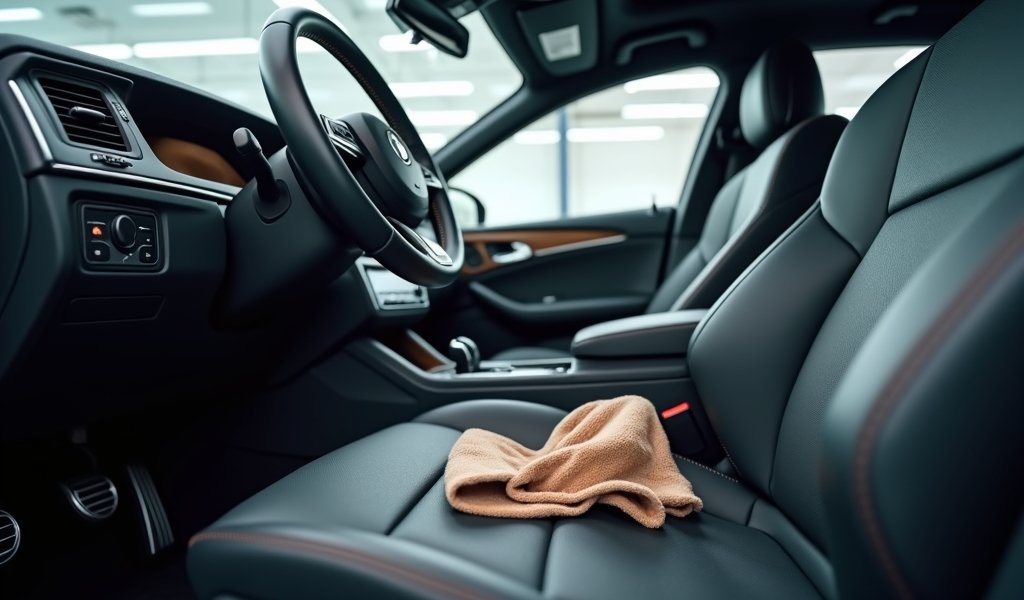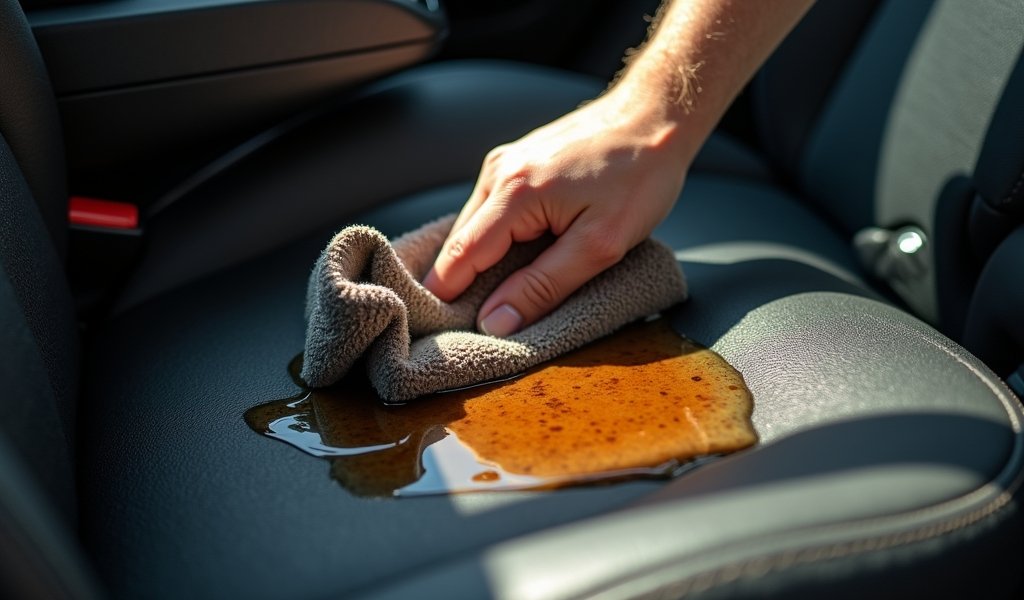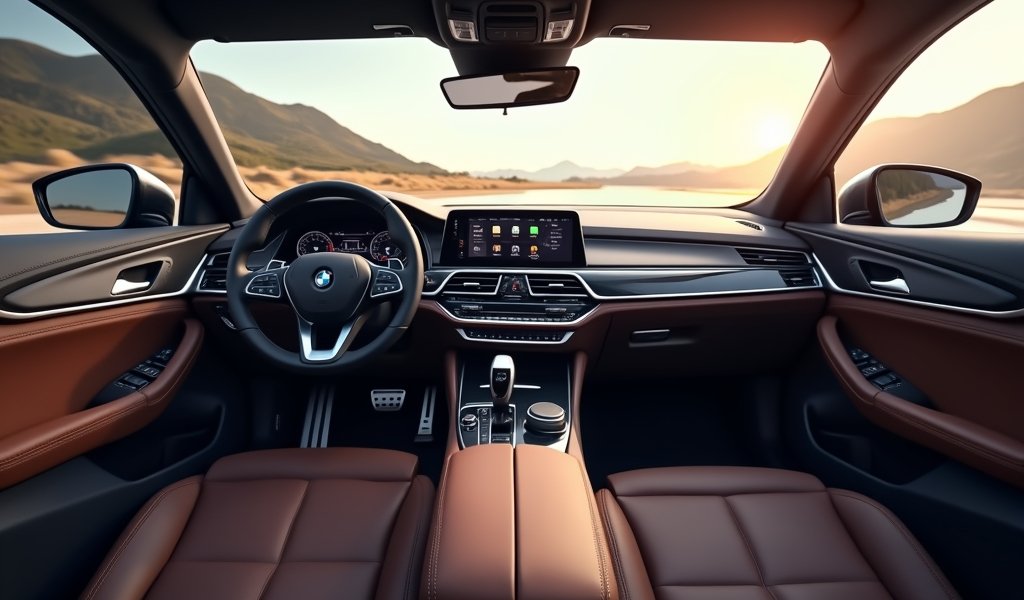Overview
This article provides practical guidance for handling coffee spills in car interiors, covering immediate response techniques, specific cleaning methods for different surfaces, and product recommendations. It emphasizes quick action using appropriate cleaners, explains DIY solutions for emergencies, and offers prevention strategies to avoid future spills while maintaining your vehicle’s interior condition.
Table of Contents
- The Coffee Catastrophe: When Your Morning Brew Meets Your Car Interior
- Why Coffee Stains Are So Stubborn (And Why You Need to Act Fast)
- Essential Supplies for Coffee Spill Emergencies
- The Golden Minutes: Immediate Response to Fresh Coffee Spills
- Tackling Coffee Stains on Different Interior Surfaces
- DIY Solutions When Commercial Cleaners Aren’t Available
- Smart Prevention: Avoiding Future Coffee Disasters
- Top Car Interior Cleaners for Coffee Spills Worth Your Money
- Conclusion: Keeping Your Interior Coffee-Free
- Frequently Asked Questions
The Coffee Catastrophe: When Your Morning Brew Meets Your Car Interior
It happens in an instant. You hit a pothole during your morning commute, and suddenly your favorite car interior cleaner for coffee spills becomes an urgent necessity. That steaming cup of joe you carefully balanced is now decorating your upholstery, seeping into your car’s carpet, or pooling in your center console. As a mechanic who’s seen countless coffee casualties, I can tell you this ranks among the most common interior mishaps I encounter.
Coffee spills don’t have to spell disaster for your vehicle’s interior. With quick action and the right cleaning approach, you can prevent those dark stains from becoming permanent reminders of your morning mishap. Having worked on thousands of vehicles, I’ve developed effective techniques for treating every type of interior surface affected by coffee spills.
At Knows Your Car, we understand that your vehicle is more than transportation – it’s your sanctuary, office, and sometimes dining room. That’s why I’ve compiled this comprehensive guide to help you tackle coffee spills effectively, preserve your car’s interior, and get back to enjoying your commute (perhaps with a more spill-proof travel mug).
Why Coffee Stains Are So Stubborn (And Why You Need to Act Fast)

Coffee isn’t just any liquid when it comes to staining potential. As someone who’s detailed hundreds of vehicles, I can tell you that coffee creates particularly challenging stains for several reasons:
- Tannins – these organic compounds give coffee its color and bitter flavor, but they also bind aggressively to fabric fibers
- Oils – especially in milk-based coffees, create greasy residues that attract dirt
- Heat – warm liquids penetrate deeper into fabrics and expand material fibers, allowing stains to set more permanently
- Acidity – coffee’s natural acids can actually break down certain protective coatings on interior surfaces
What makes coffee particularly tricky is how it affects different surfaces. On porous materials like fabric and carpet, coffee quickly penetrates deep into fibers. On leather and vinyl, it can cause discoloration if not promptly removed. In crevices like seat seams and cup holders, dried coffee creates sticky residue that collects dust and debris.
The clock starts ticking the moment coffee spills. Within minutes, the liquid begins penetrating deeper into materials. Within hours, the stain begins to set. After 24 hours, removing the stain completely becomes significantly more challenging. This is why having an effective car interior cleaner for coffee spills readily available can make all the difference between a quick cleanup and a permanent stain.
Essential Supplies for Coffee Spill Emergencies
As a mechanic who’s also passionate about detailing, I keep a comprehensive cleaning kit in my own vehicle. Based on my professional experience, here’s what you should have on hand to tackle coffee spills effectively:
Commercial Cleaners Worth Having
- Upholstery-specific stain remover (look for enzymes that break down organic compounds)
- Leather cleaner and conditioner (if your interior has leather surfaces)
- All-purpose interior cleaner (for hard plastic surfaces and quick cleanup)
- Carpet spot treatment (formulated specifically for vehicle carpeting)
Household Alternatives That Actually Work
- White distilled vinegar (diluted 1:1 with water)
- Baking soda (for absorbing fresh spills and neutralizing odors)
- Mild dish soap (just a few drops in water)
- Club soda (surprisingly effective on fresh coffee stains)
Essential Tools for Effective Cleaning
- Microfiber towels (several clean ones for different stages of cleaning)
- Soft-bristled detailing brushes (to work cleaner into fabrics without damaging them)
- Spray bottles (for your DIY cleaning solutions)
- Paper towels or shop towels (for initial blotting)
- Portable vacuum with upholstery attachment (to remove coffee grounds and residual cleaning products)
Having these supplies ready means you won’t waste precious minutes searching for cleaning materials when time is critical. I recommend keeping a compact emergency cleaning kit in your glove compartment or trunk. This preparation has saved countless upholstery surfaces in my years working with vehicles.
The Golden Minutes: Immediate Response to Fresh Coffee Spills
When coffee splashes in your vehicle, you’ve entered what I call the “golden minutes” – that critical window where your actions determine whether you’ll be left with a permanent stain. Here’s my professional approach to immediate coffee spill response:
1. Blot Immediately (Don’t Rub!)
Grab paper towels or a clean cloth and blot the spill gently. Pressing down and lifting repeatedly pulls liquid up and out of the fabric. Rubbing will push coffee deeper into the material and spread the stain.
2. Remove Coffee Grounds
If your coffee had grounds in it (like cold brew or French press), carefully pick them out before they embed in the fabric. A plastic spoon edge can help scoop them up without grinding them into the upholstery.
3. Apply Cold Water
For fresh spills, lightly dampen a clean cloth with cold water and continue blotting. This dilutes the coffee and prevents it from setting. Avoid using hot water, which can set the stain permanently by activating the proteins in cream or milk.
4. Apply Your Car Interior Cleaner for Coffee Spills
Now’s the time to apply your dedicated cleaner. Spray it lightly onto the affected area – don’t soak the surface. Allow it to dwell for the time specified on the product (usually 2-5 minutes).
5. Work from Outside In
When cleaning, always work from the outside edges of the spill toward the center. This technique prevents spreading the stain to clean areas. I’ve seen too many DIYers make this mistake, turning a small stain into a larger one.
6. Rinse and Repeat if Necessary
Blot away the cleaner with a damp cloth, then follow with a dry one. For stubborn stains, you may need to repeat the process, but allow surfaces to dry between applications to assess your progress.
I’ve seen dramatic differences in outcomes based solely on how quickly vehicle owners responded to coffee spills. When a client follows these steps within the first few minutes, we can often avoid any permanent damage entirely. DIY car detailing tips like these can save you hundreds in professional cleaning services.
Tackling Coffee Stains on Different Interior Surfaces

Each surface in your vehicle requires specific cleaning approaches when dealing with coffee spills. After working on countless interiors, I’ve perfected techniques for each material:
Fabric Upholstery and Carpets
Fabric seats and carpeting are the most common victims of coffee spills, and unfortunately, they’re also the most challenging to clean. Here’s my professional approach:
- After blotting excess liquid, spray a fabric-specific car interior cleaner for coffee spills directly on the stain
- Allow the cleaner to penetrate for 3-5 minutes (but don’t let it dry completely)
- Use a soft upholstery brush to gently agitate the cleaner into the fabric using circular motions
- Blot with clean, damp microfiber towels
- For stubborn stains, try an enzyme-based cleaner that specifically breaks down coffee compounds
- Allow the area to dry completely before using the seat again (a fan can speed this process)
For particularly stubborn fabric stains, enzyme-based carpet cleaners can break down coffee stains effectively. These specialized formulas actually digest the organic compounds that cause staining.
Leather Surfaces
Leather requires special care – harsh cleaners can damage the finish and dyes. My approach for leather is more gentle:
- Blot up excess coffee immediately with a clean, dry cloth
- Use a pH-balanced leather cleaner specifically designed for automotive leather
- Apply with a soft microfiber cloth using gentle circular motions
- Wipe away with a clean, slightly damp cloth
- Allow the leather to dry naturally (avoid heat sources)
- Apply a quality leather conditioner after cleaning to restore moisture
Remember that leather is skin and requires moisturizing after cleaning to prevent drying and cracking. This two-step process is essential for maintaining the integrity of your leather surfaces.
Hard Surfaces and Cup Holders
Those pesky cup holders seem designed to collect coffee residue. Here’s how to tackle these hard-to-reach areas:
- For removable cup holders, take them out and wash with warm, soapy water
- For fixed cup holders, use a dampened microfiber cloth with all-purpose interior cleaner
- Use cotton swabs or small detailing brushes to reach into crevices
- For sticky residue, a diluted solution of isopropyl alcohol can break down the sugars
- Wipe down thoroughly with a clean, damp cloth to remove any cleaning product residue
- Don’t forget to clean the center console, door panels, and dashboard where coffee may have splashed
For those tiny crevices around buttons and controls, I recommend using compressed air to blow out coffee residue before it becomes sticky and attracts dust. This simple step can prevent the deterioration of electronic components over time.
When dealing with extensive coffee damage across multiple surfaces, you might want to consider car interior shampoo services near you for a thorough, professional cleaning.
DIY Solutions When Commercial Cleaners Aren’t Available
Sometimes a coffee spill happens when you don’t have your commercial cleaners on hand. Over my years in the shop, I’ve developed these reliable DIY solutions that use common household items:
Basic Homemade Upholstery Cleaner
- Mix 1 tablespoon mild dish soap with 2 cups cold water in a spray bottle
- Spray lightly on the affected area and blot with a clean cloth
- Follow with a damp cloth to remove soap residue
Vinegar Solution for Stubborn Coffee Stains
- Combine equal parts white vinegar and cool water
- Apply to the stain with a clean cloth, blotting gently
- The acidity helps break down coffee stains while neutralizing odors
- Rinse by blotting with clean water and dry thoroughly
Baking Soda Paste for Set-In Stains
- Mix baking soda with just enough water to form a paste
- Apply to the stained area and let dry completely
- Vacuum thoroughly to remove all residue
- This works particularly well for older stains and helps eliminate coffee odors
Club Soda Technique
- Pour a small amount of club soda directly on fresh coffee stains
- Blot immediately with a clean towel
- The carbonation helps lift the stain while the sodium bicarbonate neutralizes acids
I’ve used these DIY methods countless times in emergency situations. They’re remarkably effective, especially on fresh spills. The key is acting quickly and having these common household items accessible. Professional detailing techniques often incorporate these same principles, just with specialized products.
Smart Prevention: Avoiding Future Coffee Disasters
As someone who’s cleaned hundreds of coffee-stained vehicles, I can tell you that prevention is far easier than cleanup. Here are my top recommendations for preventing coffee spills:
Invest in Quality Travel Mugs
Not all travel mugs are created equal. Look for these features:
- True 360° leakproof seals (test before trusting!)
- Vacuum-insulated stainless steel construction
- Auto-sealing lid mechanism that closes when not in use
- Proper fit for your vehicle’s cup holders
Cup Holder Accessories Worth Having
- Expandable cup holder adapters that securely grip different cup sizes
- Neoprene cup holder liners that absorb minor spills
- Anti-slip cup holder mats that prevent drinks from tipping
Strategic Habits
- Wait until you’re stopped at a light to take a sip
- Check that your lid is properly secured before starting your drive
- Consider using a drink holder that attaches to your air vent (away from electronics)
- Use seat gap fillers to prevent spills from reaching under-seat areas
Many of my customers have dramatically reduced interior cleaning needs by simply upgrading to a quality travel mug. This small investment can save hundreds in potential interior damage and cleaning costs. For those who enjoy learning how to care for their vehicles properly, learning to detail your car like a pro can be both satisfying and cost-effective.
Top Car Interior Cleaners for Coffee Spills Worth Your Money
After testing countless products on coffee-stained interiors, these are the car interior cleaners for coffee spills that consistently deliver professional results:
For Fabric and Upholstery
- Chemical Guys Fabric Clean – Particularly effective on coffee stains because it contains natural enzymes that break down organic matter. Works well even on old, set-in stains.
- Meguiar’s Carpet & Upholstery Cleaner – The foam formula lifts coffee stains while minimizing wetness, which helps prevent the growth of mildew in padding underneath.
- CarGuys Super Cleaner – A versatile option that works surprisingly well on fresh coffee spills across multiple surfaces.
For Leather Surfaces
- Leather Honey Cleaner – Gentle yet effective on coffee spots without drying out your leather. The non-toxic formula is safe for all leather finishes.
- Chemical Guys Leather Cleaner and Conditioner – The two-step system ensures leather stays supple after cleaning coffee stains.
- Lexol pH-balanced Leather Cleaner – Specifically formulated to remove stains without affecting leather dyes or finishes.
For Hard Surfaces and Cup Holders
- Invisible Glass Cleaner – Cuts through coffee residue on surfaces without leaving streaks or residue.
- 303 Aerospace Protectant – After cleaning, this product helps prevent future stains from setting into plastic surfaces.
- Meguiar’s Quik Interior Detailer – Perfect for quick coffee spill response on dashboards and consoles.
Based on my experience in the shop, keeping at least one fabric cleaner and one all-purpose cleaner in your vehicle can make the difference between a quick cleanup and a permanent stain. For leather interiors, I always recommend a dedicated leather cleaner rather than an all-purpose product, as leather requires specific pH-balanced formulations to prevent damage.
These recommendations come from real-world testing on actual customer vehicles, not just manufacturer claims. The most effective products contain surfactants that break the surface tension of the coffee, allowing it to be lifted from the material rather than just pushing it around.
Conclusion: Keeping Your Interior Coffee-Free
Coffee spills happen to the best of us, but they don’t have to result in lasting damage to your vehicle’s interior. As a mechanic who’s dealt with countless coffee catastrophes, I can assure you that prompt action with the right car interior cleaner for coffee spills makes all the difference. Remember the golden rule: blot, don’t rub, and tackle the spill as quickly as possible.
The right approach varies by surface – what works for fabric won’t necessarily work for leather. Having a small cleaning kit in your vehicle prepares you for those inevitable moments when your morning brew decides to redecorate your interior. And investing in quality travel mugs and spill-prevention accessories can save you considerable cleaning effort in the long run.
At Knows Your Car, we’re committed to helping you maintain your vehicle’s appearance and value. Whether it’s coffee spills or regular maintenance, taking care of small issues promptly prevents them from becoming major problems down the road. Remember that a well-maintained interior not only makes your daily commute more pleasant but also preserves your vehicle’s resale value.
Next time you’re enjoying that cup of coffee on the go, drive confidently knowing you’re prepared to handle any spills that come your way. Your car’s interior will thank you, and so will your future self when it comes time to trade in or sell your well-maintained vehicle.
Frequently Asked Questions
Can coffee stains be removed from car seats after they’ve dried?
Yes, dried coffee stains can be removed using enzyme-based cleaners that break down the coffee compounds. Multiple applications might be necessary for complete removal of old stains.
Will coffee stains damage my leather seats permanently?
Coffee can permanently stain leather if not cleaned promptly, especially on light-colored upholstery. Quick action with a pH-balanced leather cleaner minimizes this risk.
How long should I wait before sitting on a cleaned car seat?
Allow the seat to dry completely, which typically takes 2-4 hours depending on ventilation and humidity. Using a fan can significantly reduce drying time.
Can I use bleach to remove coffee stains from car upholstery?
Never use bleach on car upholstery as it can damage fabrics, remove dyes, and weaken materials. Stick to automotive-specific cleaners or mild DIY solutions instead.
What’s the best way to remove coffee smell from my car interior?
After cleaning the spill, use baking soda to absorb odors or an enzyme-based odor eliminator specifically formulated for vehicles. Avoid masking sprays that only temporarily cover the smell.

